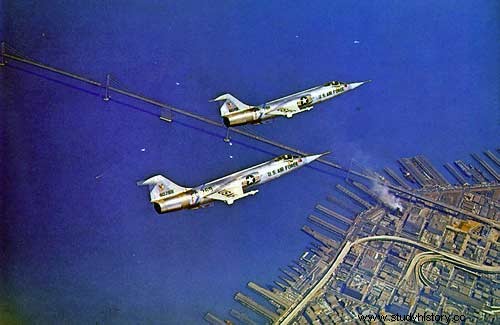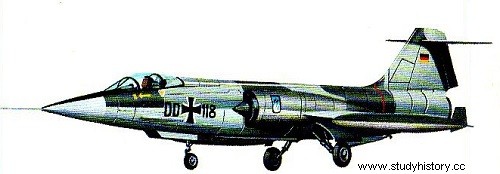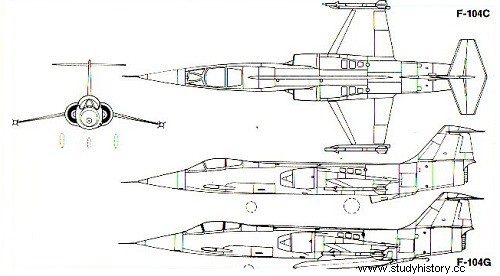
From the first flight of the prototype, on February 7, 1954, observers defined the device as:“a piloted missile”. With a long, pointed fuselage, virtually non-existent wings, and exceptional speed, the Starfighter looked anything but traditional aircraft. The facts quickly contradicted this impression. The futuristic appearance of the F-104 did not detract from its operational capabilities:built in all thousands of copies not only in the United States but also in Europe, Canada and Japan, adopted by the military aviation of almost all Western countries, still in front-line service in the second half of the seventies, the Starfighter became the most widespread bisonic combat aircraft of its time. The project was born in 1952, following precise official notes issued by the USAF. Indeed, after the experience of the Korean conflict, the need to have a fighter aircraft characterized by outstanding performance appeared imperative:the main objective was to achieve a diurnal interceptor flying at a Mach 2 speed.
Despite the complexity of the task, Lockheed engineers, led by Clarence “Kelly” Johnson, managed to overcome all the difficulties and technical problems in a short time. In March 1953, the order arrived requesting the construction of two prototypes called XF-104. The first of these flew for the first time less than a year later. Flight tests revealed a series of limited operational performance, mainly due to the low load capacity of the aircraft. From then on, Lockheed decided to review the basic project to a large extent and to modify it according to a more powerful turbojet engine. Thus designed, the Starfighter was built in 15 pre-production units, called YF-104A. Then followed other structural modifications, relating to the air intakes of the engine and the landing gear, after which the Americans finally started the initial production of 155 F-104A and 26 F-104B, these last two-seaters to be used for instruction. Deliveries to detachments began at the end of January 1958 Characterized by a general strengthening of the structure, greater load capacity, a more powerful engine and changes to the vertical planes, the next version, the F-1040 , appeared in the same year and became operational in October.
The United States manufactured 77 specimens of the basic version F-104C and 22 of the two-seater model F-104D. These Starfighters were the first to be exported, to Japan and Germany:the Japanese acquired 20 copies, baptized F-104W and the Germans 30, called F-104F. The export - and the need to provide the allied countries with a good common combat aircraft - determined the second phase, the most important, of the career of the Starfighter. Indeed, in 1958, Lockheed started the project of a new version, specially studied taking into account the requirements of Federal Germany and called F-104G, characterized by a more robust structure and train, a more powerful engine. powerful, wings with a larger surface area and more sophisticated electronic equipment. The first Super Starfighter (official name of the plane) flew on June 7, 1960 and the Lockheed factories produced 101 examples of the single-seat model (96 intended for the
Luftwaffe, 3 to power licensed production in Japan and 2 for the same reason in Belgium and Italy) and 200 of the two-seater version, called TF-104G. The enormous license production program in Europe, Japan and Canada constituted a very considerable industrial effort, unprecedented since the Second World War:1,300 units were ordered from the European consortium. The Canadians produced 378 aircraft (200 single-seaters called CF-104 and 38 two-seater CF-104D, equipped with on-board equipment very modified from that of the original versions, and 140E-104G of the standard type); the Japanese, them, manufactured 239 F-104J equipped with a more powerful armament. Starfighters equipped the air forces of Germany, Italy, the Netherlands, Belgium, Canada, Turkey, Greece, Denmark and Norway.
In addition, Nationalist China received fifty copies directly from the United States. Production continued with the completion of the latest version, the F-104S. The Italian government acquired the construction license and entrusted it to Fiat, which had already been chosen to build the Super Starfighter in Italy. After the transfer of its Aviation Division to Aeritalia, the Turin factory carried out the production program which amounted to 205 units intended for military aviation. Characterized by a more powerful version of the J79 turbojet engine, also built under license, by more modern electronic equipment and by a significant increase in performance and warhead, which included Sparrow air-to-air missiles, these aircraft began to enter online in 1969 and gradually replaced the F-104G both in the role of interceptors and fighter-bombers. To the order intended for the Italian Military Aviation was added, in 1974, another 18 copies placed by the Turkish Air Force.
During its long career, the Starfighter also conquered several records:on May 7, 1958, an F-104A broke the world altitude record by reaching 27,813 meters and, on May 16, that of average speed of 2,259, 85 kilometers per hour:it thus became the first aircraft to hold both records simultaneously. On December 14, 1959, an F-104C managed to improve the altitude record and climbed to 31,513 meters.
Operational service
In the US Air Force
USAF Air Defense Command
The F-104A was used for some time as an interceptor by the USAF Air Defense Command/Aerospace Defense Command, although the Starfighter's armament and range were hardly suited to this mission. On February 20, 1958, the 83 rd Fighter Interceptor Squadron from Hamilton AFB was the first unit to be operational on F-104A. After a series of accidents due to the engines of its F-104A, the unit was grounded after only three months of activity. Flights did not resume until the engines had been replaced by J79-3Bs, and three new ADC units were transformed into F-104As. At the same time, the USAF reduced its initial order of 722 Starfighters to 155.
ADC Starfighters were withdrawn from active duty units after one year of service and transferred to units of the Air National Guard. However, it is important to remember that the F-104 was designed as a standby solution before the F-106 Delta Darts were delivered.
Tactical Air Command
The next version, F-104C, entered service with Tactical Air Command as a multirole fighter-bomber. The 479th Tactical Fighter Wing6 of George Air Force Base was the first unit to fly on this device from September 1958. Although it was hardly suitable for the theater of operations, the F-104 was used for a few missions during the Vietnam War. In 1967, the TAC Starfighters were transferred to the Air National Guard.
Vietnam War
The Starfighter's participation began during Operation Rolling Thunder in 1965. Although they were used in air superiority and air support missions, the F-104s saw little engagement with enemy aircraft. and no victories but nevertheless had an important deterrent role against the MiGs.
The first of two Starfighter deployments to Vietnam took place between April 1965 and November 1965 with a total of 2,937 combat sorties. During this deployment, two F-104s were shot down by ground fire, another shot down by a Shenyang J-6 (Chinese version of the MiG-19) as it passed over the border and two others finally lost following a mid-air collision during a combat engagement.
The 476th Tactical Fighter Squadron deployed from April 1965 to July 1965, losing one Starfighter. The 436th TFS meanwhile lost four aircraft during its deployment from July 1965 to October 1965.
The Starfighters experienced their second deployment to Vietnam when the 435th TFS stayed there from June 1966 to July 1967 completing 2,269 combat sorties. Nine other F-104s were lost:two victims of fire from the ground, three shot down by surface-to-air missiles and four following mechanical incidents (engine problems).
As they were replaced by F-4 Phantom IIs in July 1967, a total of fourteen F-104s had been lost in Vietnam.
F-104s in service in Vietnam were retrofitted with APR-25/26 warning radar receivers, one of which is still on display at the Air Zoo in Kalamazoo, Michigan.
End of service in America
The USAF was not very satisfied with the Starfighter and only ordered 296 single-seater and two-seater copies of it, all versions combined. At that time, USAF doctrine left little room for air superiority (the “real” fighter missions), and the Starfighter did not seem to meet the needs of an interceptor or a tactical fighter-bomber. , as it lacked both the payload capacity and survivability of other fighters of the time in service with the USAF.
Its use in the USAF declined by late 1965, with the last Starfighters in active service leaving the USAF in 1969. The F-104 nevertheless remained in the ranks of the Puerto Rico National Guard until 1975.
The last Starfighters to fly under American colors were the Luftwaffe F-104G and TF-104G based at Luke Air Force Base (Arizona) for training German pilots. Despite their USAF roundels, these Starfighters (some of which were built in Germany) were actually German-owned. They continued to fly until 1983. It was one of these planes that was used during the filming of The Right Stuff.
Taiwan Strait conflict in 1967
On January 13, 1967, four Republic of China Air Force F-104Gs engage a formation of Chinese Air Force 12MiG-19s over Kinmen Island. A MiG-19 was shot down as well as an F-104.
Indo-Pakistani Wars
In the early morning of September 6, 1965, Pakistani Flight Lieutenant Aftab Alam Khan marked the start of dogfights during the 1965 India-Pakistan War by claiming an aerial victory in his F-104 against an Indian Mystery IV. . This victory, disputed by the Indians, would be the first aerial victory of an aircraft capable of reaching Mach 2 and the first missile victory of the Pakistan Air Force (PAF).
The PAF lost one F-104 during operations in 1965 while claiming two kills over Indian aircraft.
A Starfighter is believed to be behind the interception of an Indian Air Force Gnat on September 3, 1965. F-104s were directed at the Gnat flying over Pakistan as it returned to base of origin. The very close supersonic passages of the F-104s forced the pilot of the Gnat to surrender, lower his landing gear and land on a disused Pakistani field. The Indians claim that Squadron Leader Brij Pal Singh made a navigation error which forced him to land on this Pakistani terrain. He was held as a prisoner of war before being released (he ended his career with the rank of Air Marshall). The Indian Gnat is now on display at the PAF Museum in Karachi.
During the 1971 war, and especially after the introduction of the MiG-21 in India, the Starfighter was hardly considered a real threat. Four F-104s were lost in combat with MiG-21s. One of the pilots managed to eject himself above the sea, but Indian rescuers were unable to find the pilot in the shark-infested waters. An Indian Navy Alizé was nevertheless shot down by a Pakistani F-104 returning from a canceled mission.
International Service
At the same time that the F-104 was falling out of favor in the United States, the German Luftwaffe took a keen interest in the multirole fighter. The F-104G was presented as a conversion from a clear-weather fighter to an all-weather fighter specializing in ground attack, reconnaissance and interception. The aircraft found an additional market with other NATO countries, eventually leading to the production of 2,578 aircraft of all versions in the United States, but also and above all under license in other countries. Seven countries received their Starfighters under the US Military Aid Program (MAP). American reactors were selected and built under license in Europe, Canada and Japan. The Lockheed ejection seat initially chosen was later replaced in some countries by Martin-Baker zero-zero reputed to be safer.
User countries
The F-104 was in service with the air forces of the following countries:
West Germany

The 916 F-104s received by West Germany (749 R/F-104G, 137 TF-104G and 30 F-104F17) formed the main combat aircraft of the Luftwaffe and the air component of its navy, the Marineflieger. At the peak of its use, the Luftwaffe had five ground attack wings (or Geschwader), two interceptor wings and two reconnaissance wings equipped with F-104s. Two additional navy squadrons had anti-surface attack and maritime reconnaissance missions.
The Starfighter entered service with the Luftwaffe in July 1960, with deliveries continuing through March 1973. The last Luftwaffe F-104s left front line units on 16 October 19873 while continuing to be used in test units until May 22, 1991.
Both RF-104G squadrons transitioned to RF-4E Phantom in the early 1970s.
The Marineflieger began using AS.30 missiles in their anti-ship missions before replacing them with the more modern AS.34 Kormoran.
The German Starfighters had an alarming loss rate which gave it its nickname of "Widowmaker" or "Fallfighter" (flying coffin). 292 of the 916 German F-104s crashed, causing the death of 119 pilots. 1/3 of the accidents of this single-engine aircraft were attributed to the engine stopping during flight, which subsequently led the Luftwaffe to select only twin-engine aircraft for the renewal of its fleet.
Belgium
Belgium used 101 F-104Gs built under license by SABCA and 12 two-seater TF-104Gs built by Lockheed, one F-104G having crashed before delivery. The Starfighter served with the Belgian Air Force for just over twenty years, between February 14, 1963 and September 19, 1983, before being replaced by F-16s. The remaining 23 were sold to Taiwan and 18 to Turkey. 38 F-104G and 3 TF-104G were lost in accidents.
Canada
The first five CF-104s built in 1961 in training. All are built at Canadair's Cartieville plant except the 702 built at Air Force Plant 42 Palmdale.
The RCAF, unified in 1968 with the other three arms in the Canadian Forces, used between 1962 and 1986 a total of 200 CF-104s built by Canadair at the Cartierville plant and 38 two-seater CF-104Ds built by Lockheed. Nearly 110 aircraft crashed in Europe, its intensive use, especially in attack and reconnaissance missions at very low altitude, as well as bad weather conditions were the cause of nearly 50% of the losses. The Canadian aircraft had an average of 6,000 flight hours on the clock when they were retired, which is triple that of the German Starfighters. Surplus CF-104s were transferred to Denmark, Norway and Turkey.
Denmark
Denmark initially received 25 license-built F-104Gs from Canadair and 4 TF-104Gs from Lockheed under the MAP assistance program. Surplus Canadian aircraft were transferred later between 1972 and 1974 (15 CF-104s and 7 CF-104Ds). A total of 51 Starfighters were therefore used by the Danish Air Force before their retirement from service in 1986. 15 F-104Gs and 3 TF-104Gs were transferred to Taiwan in 1987.
Spain
The Spanish Air Force also received F-104s under the Military Assistance Program:18 F-104Gs built by Canadair (C.8) and 3 TF-104Gs built by Lockheed (CE.8) were delivered to Spain. Ejercito del Aire in 1965.
When replaced by F-4C Phantom IIs in 1972, these Starfighters were transferred to Greece and Turkey. It is worth noting that no Spanish Starfighter was lost despite having flown over 17,000 hours. It is true that Spain only used the Starfighter in its initial role as an interceptor and in mostly excellent weather.
United States
United States Air Force
Greece
Greece received 45 F-104Gs and 6 TF-104Gs first-hand under the MAP agreements. This initial delivery was later supplemented by numerous second-hand F-104s from other NATO countries, including 79 from Germany, 7 from the Netherlands and 9 from Spain. Entering service in Greece in April 1964, the last Greek Starfighters left active service in March 1993, having equipped two squadrons.
Italy
The F-104 was a key component of the Aeronautica militare (Italian Air Force) from the early 1960s until the end of the 20th century. MM6501, the first Italian F-104G was built by Lockheed, the first Starfighter built by Fiat/Aeritalia flying two years later, on October 5, 1962. Italy received an initial delivery of 105 F-104G, 24 TF-104G and 20 RF-104G, operational in March 1963. 205 F-104S and 6 TF-104G having belonged to the Luftwaffe later completed this fleet, bringing the total to 360 Starfighters. In 1986, the Aeronautica militare (AMI) was the largest F-104 user with eleven operational units. Until 1997, the AMI lost 137 of its F-104s (i.e. 38% of the total) in 928,000 flight hours (i.e. 14.7 aircraft per 100,000 hours). The F-104 was officially retired from service in 2004 during a ceremony in Pratica de Mare.
dates
 commissioning date:1958
commissioning date:1958
 use end date:
use end date:
Nationalities
 Manufacturer:
Manufacturer:
- USA
Users :
USA
Canada
Germany
Categories
Hunter

Technical and Performance Data
 Wingspan:6.68 m.
Wingspan:6.68 m.
 Length:16.68 m.
Length:16.68 m.
 Height:4.11 m.
Height:4.11 m.
 Weight:10,701 kg
Weight:10,701 kg
 Maximum weight:
Maximum weight:
 Maximum Load:
Maximum Load:
 Surface:
Surface:
 Maximum altitude:16,765 m
Maximum altitude:16,765 m
 Range:724 km.
Range:724 km.
 Maximum speed:2,494 km/h at 12,190 m altitude
Maximum speed:2,494 km/h at 12,190 m altitude
 Ascent Rate:
Ascent Rate:
 Practice Cap:
Practice Cap:
 Cruising speed:
Cruising speed:

Motorisation (engines or reactors)
 General Electric J79GE-7 7,167 kg thrust turbojet engine
General Electric J79GE-7 7,167 kg thrust turbojet engine
Armaments
 1 x 20mm cannon
1 x 20mm cannon
 1,814 kg war load
1,814 kg war load
